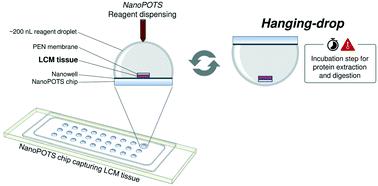Our official English website, www.x-mol.net, welcomes your feedback! (Note: you will need to create a separate account there.)
Hanging drop sample preparation improves sensitivity of spatial proteomics
Lab on a Chip ( IF 6.1 ) Pub Date : 2022-07-12 , DOI: 10.1039/d2lc00384h Yumi Kwon 1 , Paul D Piehowski 1 , Rui Zhao 1 , Ryan L Sontag 2 , Ronald J Moore 2 , Kristin E Burnum-Johnson 1 , Richard D Smith 2 , Wei-Jun Qian 2 , Ryan T Kelly 1, 3 , Ying Zhu 1
Lab on a Chip ( IF 6.1 ) Pub Date : 2022-07-12 , DOI: 10.1039/d2lc00384h Yumi Kwon 1 , Paul D Piehowski 1 , Rui Zhao 1 , Ryan L Sontag 2 , Ronald J Moore 2 , Kristin E Burnum-Johnson 1 , Richard D Smith 2 , Wei-Jun Qian 2 , Ryan T Kelly 1, 3 , Ying Zhu 1
Affiliation

|
Spatial proteomics holds great promise for revealing tissue heterogeneity in both physiological and pathological conditions. However, one significant limitation of most spatial proteomics workflows is the requirement of large sample amounts that blurs cell-type-specific or microstructure-specific information. In this study, we developed an improved sample preparation approach for spatial proteomics and integrated it with our previously-established laser capture microdissection (LCM) and microfluidics sample processing platform. Specifically, we developed a hanging drop (HD) method to improve the sample recovery by positioning a nanowell chip upside-down during protein extraction and tryptic digestion steps. Compared with the commonly-used sitting-drop method, the HD method keeps the tissue pixel away from the container surface, and thus improves the accessibility of the extraction/digestion buffer to the tissue sample. The HD method can increase the MS signal by 7 fold, leading to a 66% increase in the number of identified proteins. An average of 721, 1489, and 2521 proteins can be quantitatively profiled from laser-dissected 10 μm-thick mouse liver tissue pixels with areas of 0.0025, 0.01, and 0.04 mm2, respectively. The improved system was further validated in the study of cell-type-specific proteomes of mouse uterine tissues.
中文翻译:

悬滴样品制备提高了空间蛋白质组学的灵敏度
空间蛋白质组学对于揭示生理和病理条件下的组织异质性具有很大的前景。然而,大多数空间蛋白质组学工作流程的一个显着限制是需要大量样本,这会模糊细胞类型特定或微观结构特定信息。在这项研究中,我们开发了一种改进的空间蛋白质组学样品制备方法,并将其与我们之前建立的激光捕获显微切割 (LCM) 和微流体样品处理平台相结合。具体来说,我们开发了一种悬滴 (HD) 方法,通过在蛋白质提取和胰蛋白酶消化步骤期间将纳米孔芯片倒置来提高样品回收率。与常用的坐落法相比,HD法使组织像素远离容器表面,从而提高提取/消化缓冲液对组织样本的可及性。HD 方法可以将 MS 信号增加 7 倍,从而导致识别的蛋白质数量增加 66%。平均 721、1489 和 2521 种蛋白质可以从 0.0025、0.01 和 0.04 mm 区域的激光解剖的 10 μm 厚的小鼠肝脏组织像素中定量分析2,分别。改进后的系统在小鼠子宫组织细胞类型特异性蛋白质组的研究中得到进一步验证。
更新日期:2022-07-15
中文翻译:

悬滴样品制备提高了空间蛋白质组学的灵敏度
空间蛋白质组学对于揭示生理和病理条件下的组织异质性具有很大的前景。然而,大多数空间蛋白质组学工作流程的一个显着限制是需要大量样本,这会模糊细胞类型特定或微观结构特定信息。在这项研究中,我们开发了一种改进的空间蛋白质组学样品制备方法,并将其与我们之前建立的激光捕获显微切割 (LCM) 和微流体样品处理平台相结合。具体来说,我们开发了一种悬滴 (HD) 方法,通过在蛋白质提取和胰蛋白酶消化步骤期间将纳米孔芯片倒置来提高样品回收率。与常用的坐落法相比,HD法使组织像素远离容器表面,从而提高提取/消化缓冲液对组织样本的可及性。HD 方法可以将 MS 信号增加 7 倍,从而导致识别的蛋白质数量增加 66%。平均 721、1489 和 2521 种蛋白质可以从 0.0025、0.01 和 0.04 mm 区域的激光解剖的 10 μm 厚的小鼠肝脏组织像素中定量分析2,分别。改进后的系统在小鼠子宫组织细胞类型特异性蛋白质组的研究中得到进一步验证。


























 京公网安备 11010802027423号
京公网安备 11010802027423号